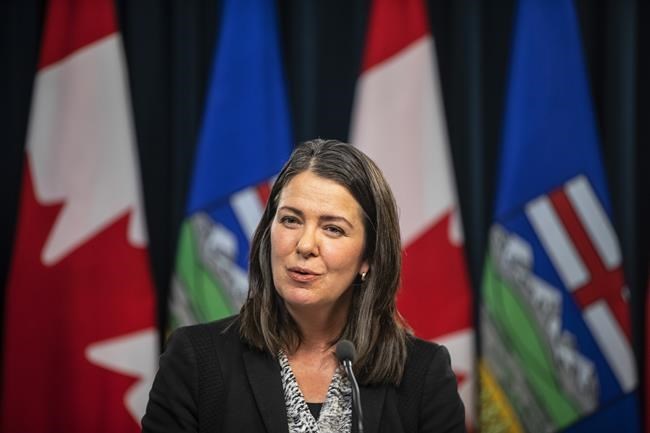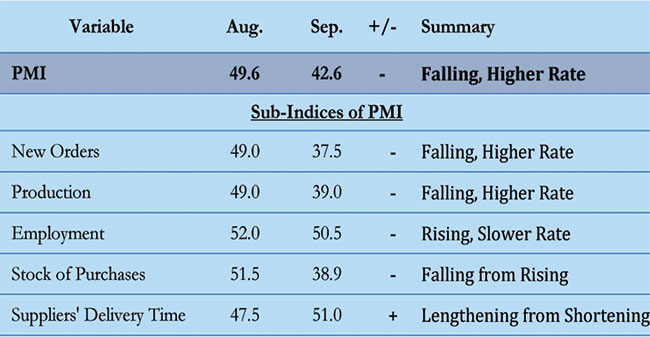Biden plans floating platforms to develop offshore wind power
FILE – President Joe Biden shows a wind turbine size comparison chart during a meeting in the Roosevelt Room of the White House in Washington, June 23, 2022, with governors, labor leaders and private companies launching the federal-state partnership for the implementation of offshore wind power. The Biden administration says it will hold its first offshore wind energy auction next month. It offers nearly 500,000 acres off New York and New Jersey for wind energy projects that could generate enough electricity to power nearly 2 million homes. (AP Photo/Susan Walsh, File)
PA
WASHINGTON
The Biden administration on Thursday announced plans to develop floating platforms in the deep ocean for wind towers that could power millions of homes and dramatically expand offshore wind power in the United States.
The plan would target sites in the Pacific Ocean off the coasts of California and Oregon, as well as in the Atlantic in the Gulf of Maine.
President Joe Biden hopes to deploy up to 15 gigawatts of electricity through floating sites by 2035, enough to power 5 million homes. The administration previously set a target of 30GW of offshore wind power by 2030 using traditional technology that secures wind turbines to the ocean floor.
There are only a handful of floating offshore platforms in the world – all in Europe – but officials said the technology is growing and could soon make the United States a world leader in offshore wind.
The offshore wind push is part of Biden’s efforts to promote clean energy and fight global warming. Biden has pledged to halve greenhouse gas emissions by 2030. A climate and tax bill he signed last month would spend about $375 billion over 10 years to boosting electric vehicles, reviving renewable energies such as solar and wind power and developing alternative energy sources such as hydrogen.
“Today we are launching efforts to seize a new opportunity – floating offshore wind – which will allow us to build in deep water areas where turbines cannot be fixed directly to the sea floor, but where there is there are strong winds that we can now harness,’ White House climate adviser Gina McCarthy said at a press conference on Thursday.
Deep-water areas of the Pacific in particular have the potential to significantly expand offshore wind power in the United States, McCarthy and other officials said.
McCarthy acknowledged that floating technology is in its infancy. But she said “coordinated actions” by federal and state officials, in conjunction with the private sector, can position the United States “to lead the world on floating offshore wind and bring offshore wind jobs to more than regions of our country, including the west coast. ‘
Two pilot projects are planned off the northern and central coasts of California, and a third is planned in southern Oregon, officials said.
Oregon Governor Kate Brown said her state and California have some of the best wind resources in the world, but called floating platforms essential to develop them due to the deep bottom of the ocean. ocean along the west coast.
Heather Zichal, CEO of the American Clean Power Association, an industry group, called the announcement a “game changer” that will spur investment in a new national supply chain and allow the United States to take the lead in this. emerging technology. Along with the incentives in the sweeping climate and tax bill, Zichal said she expects the costs of offshore wind development to come down significantly, enabling the deployment of clean energy at the scale needed to take action to combat climate change.
The Department of Energy announced nearly $50 million, including funding from the bipartisan infrastructure law that Biden signed last year, for research, development and demonstration work to support floating offshore wind platforms. Officials aim to cut the cost of floating offshore wind power by 70% by 2035, to $45 per megawatt-hour, Energy Secretary Jennifer Granholm said.
“We believe the private sector will quickly see the real opportunity here to not only triple the nation’s accessible offshore wind resources, but also to establish the United States as a world leader in the manufacture and deployment of offshore wind,” she said.
Emerging technology for floating platforms “means there is a real opportunity for greater energy security”, “affordability” “and of course tens of thousands of high-paying, in-demand jobs”, such than electricians, engineers, shipbuilders and stevedores, Granholm said.
The Biden administration “is fully poised to make floating offshore wind a real part of our energy mix and win the global race to lead in this space,” Granholm said. “And that’s why we’ve set ourselves this big, bold, hairy goal” of 15 gigawatts of floating offshore wind by 2035.
Interior Secretary Deb Haaland said her department had approved the country’s first two major offshore wind projects in federal waters and had begun reviewing at least 10 more. An offshore wind lease sale off the coasts of New York and New Jersey set new records, she said, and a lease sale also took place in North Carolina. Seven lease sales for offshore wind projects are planned by 2025.
More than half of the country’s offshore wind resources are in deep waters where traditional offshore wind foundations are not economically feasible, Haaland said, adding that “floating wind will help us reach areas that were once inaccessible. is critical because floating wind will help us build on the administration’s goal of 30 gigawatts of offshore wind power by 2030.”
The world’s first floating wind farm has been operating off the coast of Scotland since 2017. Norwegian company Equinor, which operates the 30 megawatt Hywind Scotland project, is currently building a huge floating offshore wind farm off the coast of Norway to supply electricity offshore oil and gas. the fields.
Lauren Shane, spokesperson for Equinor in the United States, said the company was optimistic about floating offshore wind and would assess possible opportunities in the United States. “We are excited about the development of offshore wind in the United States,” she said.
Another offshore wind developer with projects in the United States, Denmark-based Ørsted, also applauded the administration’s efforts.
“The administration’s innovation priority is well placed, and with the right investments and public-private partnerships, floating platforms” can expand deployment, reduce costs and bring more clean energy to millions of Americans,” said Bryan Stockton, head of regulatory affairs for Ørsted North America.
___
McDermott reported from Providence, Rhode Island.
This story was originally published September 15, 2022 2:42 p.m.





